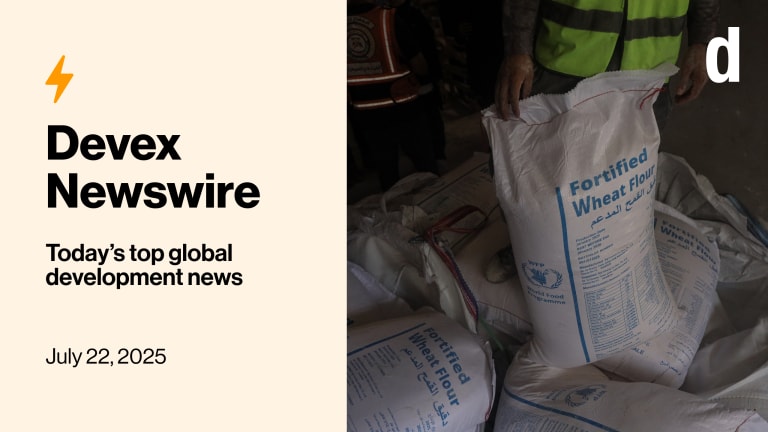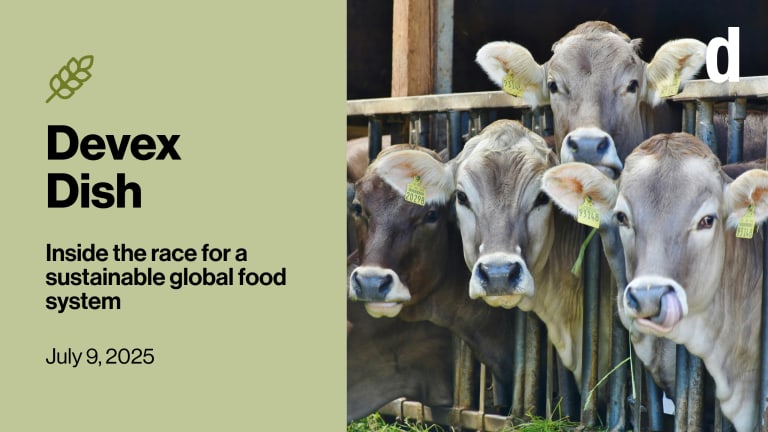
Maybe it’s the summer slowdown, or maybe it’s the upheaval of the entire U.S. foreign aid apparatus that’s left us pensive and contemplating systems change. But lately we’re hearing a lot of conversations within the development community about the way food aid is traditionally delivered.
On our minds today: What good is in-kind food aid? And isn’t it usually better to just send people cash — or, in nonemergency settings, invest in local markets and in helping them grow their own food?
The world’s largest provider of global food aid, the United States, has long chosen to provide much of it by shipping American-grown corn, wheat, soy, and other commodities abroad to places in crisis. That’s the whole model of the Food for Peace Title II initiative, as well as other programs such as McGovern-Dole Food for Education. In fiscal year 2023, the USAID-administered Food for Peace program provided $2 billion in assistance to 45 million people in 35 countries, with the majority of its operations focused on the African continent. The World Food Programme distributed much of that in-kind aid. Now, Food for Peace’s budget could be cut in half if the Trump administration has its way.
Much of the argument for keeping U.S.-grown in-kind food aid going is that it benefits American farmers and U.S. shippers, my colleague Ayenat Mersie writes. It can also sometimes be easier for recipients, for example, when food available in local markets is expensive or not very nutritious, which diminishes the usefulness of cash aid. And in-kind food aid can certainly be welcome in a crisis, when regular access to food is simply impossible.
But sending food abroad is expensive — and if the Department of Government Efficiency was looking to cut wasteful spending when it slashed the U.S. aid budget with Elon Musk at the helm, well, here’s an example: Sourcing food in the U.S. and shipping it overseas typically costs up to 34% more than buying it locally or regionally, according to the U.S. Government Accountability Office. It can also undermine local markets and food systems — which doesn’t exactly encourage self-sufficiency or help countries reduce their dependence on foreign aid. Cash aid is overall cheaper and often easier to administer.
“Our view is that in general, there isn't … a macro, large-scale need for in-kind food aid,” Jonathan Said of AGRA tells Ayenat. “Of course, you definitely have pockets [where it is needed], but that's particularly more caused by conflict and governance issues.”
Strengthening regional trade, Said says, could help so that neighboring countries can step in when one of them faces a shortage. That’s what happened during the recent drought in Southern Africa, during which Malawi and Zambia saw poor harvests and Tanzania stepped in to support them.
Whatever the arguments are for and against in-kind food aid, poorer countries and regions may have no choice but to invest in feeding themselves as the U.S. and other Western donors pull back their funding.
Read more: What good is in-kind food aid? (Pro)
Related: From ‘aid trap’ to ‘brutal’ cuts — African leaders confront a new reality (Pro)
See also: Amid aid cuts, the future of cash programming hangs in the balance
+ Curious about the insights that drive global development? Experience Devex Pro with a 15-day free trial. Explore expert analyses, unlock hidden funding opportunities, connect with key players at exclusive events, and access a wealth of knowledge you won’t find anywhere else. Check out some of the content exclusive to Pro readers
Reading the tea leaves
What does the future hold for U.S. agricultural support and food aid? Some long-running programs, such as USAID’s Feed the Future, have been totally defunded and their work halted — while others, such as Food for Peace, still have a shot at surviving President Donald Trump’s budget cuts.
Join us on Monday, July 21, as we examine what’s next. I’ll be moderating a panel for Devex Pro members that features Dina Esposito, former head of USAID’s Bureau for Resilience, Environment, and Food Security; Stephanie Mercier, senior policy adviser at the Farm Journal Foundation; and DaNita Murray, executive director of the South Dakota Corn Growers’ Association. Save your spot here.
When in Rome
The potential next U.S. ambassador to the three Rome-based U.N. food agencies is a self-described “Christian conservative,” “business builder,” and “proud member of the MAGA movement.”
Trump’s nominee for the job, Lynda Blanchard, appeared before the Senate Foreign Relations Committee last week, telling lawmakers that “the need for change and reform within the United Nations is more urgent than ever.” The Alabama native served as the U.S. ambassador to Slovenia during the first Trump administration.
If confirmed, she would represent U.S. interests at WFP, the Food and Agriculture Organization, and the International Fund for Agricultural Development and help set priorities on famine response, food aid operations, and hunger alleviation.
The U.S. spends $4 billion annually on food aid, though the Trump administration has said it will cut its contribution to the United Nations. At top FAO and WFP leadership meetings earlier this year, the U.S. was very clear about what it sought: A vision for the agencies that mirrored its own “America First” worldview, without the “unnecessary and distracting focus” on things such as climate change. And certainly no focus on the U.N. Sustainable Development Goals.
Blanchard now awaits a committee vote — and if successful, her nomination will move to the Senate floor for a full confirmation.
Read: Who is Lynda Blanchard, Trump’s pick for the top UN food agencies post?
Related: UN food agency caught in Trump administration’s crosshairs
A green windfall
Amid all the aid cuts and gloom and doom — not to mention the Trump administration’s rejection of climate change — here’s a bright spot: The Green Climate Fund has approved $1.225 billion for 17 projects in its largest single round of climate finance, while also adopting reforms that will make it easier for organizations to access the funds.
The decisions came at GCF’s board meeting earlier this month. And they show that the world’s biggest climate fund is listening to its critics — who have loudly complained for years that its accreditation process is too complex and that funds rarely each smallholder farmers and other groups on the front lines of climate change, Ayenat reports.
“We felt that 2025, given the context, we as the largest climate fund needed to keep our ambition high. We needed to make sure that we were leading that coalition of the ambitious,” Henry Gonzalez, GCF’s chief investment officer, tells Ayenat. He also pledged that GCF would cut its accreditation process down from three years to nine months.
GCF has committed some $18 billion to support 314 projects since its founding, and has a mandate to invest 50% of its resources in mitigation and 50% in adaptation, with at least half of adaptation resources going to the most vulnerable countries.
Many of the latest approved projects cover food systems. Among them is the Dairy Interventions for Mitigation and Adaptation, or DaIMA initiative — GCF’s first dedicated livestock investment, which entails $150 million to strengthen climate resilience in East Africa’s dairy sector to improve livelihoods for nearly 18 million people and mitigate up to 2.2 million tons of carbon dioxide equivalent, or CO₂e.
Read: GCF board approves record $1.2B in funding and accreditation overhaul
See also: Green Climate Fund expands its reach with first regional offices
And don’t miss: Trump reneges on $4B in Green Climate Fund financing
The costs of the UN’s war on trans fat
A draft United Nations declaration that aims to reduce the prevalence of noncommunicable diseases, or NCDs — of which many, such as cardiovascular disease, cancer, hypertension, and diabetes, are tied to unhealthy diets — proposes eliminating all trans-fatty acids from global diets. This could have the unintended consequence of restricting access to nutrition in poorer countries
That’s according to an open letter signed by more than 115 agrifood experts and government leaders, calling on animal-source foods to be excluded from the declaration. It is set to be discussed and signed by world leaders in September during the United Nations General Assembly, and a draft was released in May.
To avoid a potentially harmful misstep, the experts say, U.N. negotiators must distinguish between animal-source foods — such as meat, milk, and dairy, which naturally contain low levels of trans-fatty acids — and industrially produced sources — which can be found in many fried foods and baked goods — that carry greater health risks because they have much higher concentrations. Three out of every four people globally who die from NDCs are from lower-income countries, and much of this figure can be blamed on poor diets. In those same settings, animal-source foods are some of the most nutrient-rich and energy-dense foods available, but low consumption is connected to undernutrition.
“The risk of a blanket commitment to eliminate all trans-fatty acids is that it unnecessarily discourages the consumption of highly nutritious dairy, meat and other animal-source foods,” the letter published last week states. “And once again, the burden will fall heaviest on low- and middle-income countries, where nutrient-rich meat, milk and dairy are already under-consumed.”
The letter was coordinated by the Nairobi-based International Livestock Research Institute and endorsed by the African Union InterAfrican Bureau for Animal Resources. It is signed by experts from the U.N. Committee on World Food Security, the Global Alliance for Improved Nutrition, and representatives from national livestock ministries in Africa.
Background: Noncommunicable disease political declaration needs ‘more teeth’
See also: Noncommunicable diseases — a policy success but implementation failure
Chew on this
Bringing home the bacon
Your next job?
Manager, Regenerative Agriculture
The Rockefeller Foundation
United States
WFP is suspending food and nutritional assistance in seven West and Central African countries in response to funding cuts from the U.S. and other donors. [AP]
IFAD President Alvaro Lario says he is optimistic the agency will overcome the threat of funding cuts from the U.S., its biggest donor. [Devex]
The Trump administration is about to incinerate 500 metric tons of emergency high-energy biscuits that expire this week rather than send them abroad to people in need. [The Atlantic]
Droughts are pushing tens of millions of people to starvation as water shortages hurt crops, energy sources, and public health. [The Guardian]
A group of civil society and indigenous leaders within the U.N. Committee on World Food Security will not participate in the upcoming U.N. Food Systems Summit Stocktake+4 over concerns that it “legitimizes an agro-industrial system, and the financial interests of a few, to the detriment of peoples’ rights.” [ReliefWeb]








